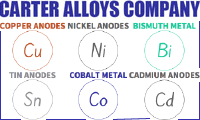
-----
Recovery of copper from electroplating & etching solutions
Q. Hi there, I'm using a simple 40 gallon acid copper electroplating system and, as others have mentioned, my bath concentration over the years has increased to the point where I need to remove some copper. At the scale I'm working at -- mostly room temperature -- it seems my options are:
1- cool/part of the bath and precipitate the copper
2- plate/winnow/dummy out to a stainless cathode.
My question is: in the case of 1) is the drop in temperature from say 60 to 45 °F going to do much? and in the case of 2) is there an affordable non-dissolving anode I can use? I don't really want to purchase a platinum anode if I can help it as it seems I'd need a rather large one.
Thanks!
Raphael
Fabricator - Brooklyn New York
January 7, 2024
A. Hi Raphael.
I haven't done it, but this is what I would try if I received no other advice. I would get a get a roll of vinyl or fiberglass screening, rinse it well, and trim it to the width of the tank, and unroll it to cover the bottom and the two ends of the tank. Then I would get a bag of ice, probably double bag it to be safe, and put it in the tank. 12 or 24 hours later I would take out the bag and try to remove any crystallization by lifting the screening.
Actually, as always, I would experiment with a beaker of the solution rather than the 40 gallons first.
I think the solubility difference between 68 °F and 40 °F or so would be sufficient. You might even save the crystals in case you overdid it :-)
Luck & Regards,

Ted Mooney, P.E. RET
Striving to live Aloha
finishing.com - Pine Beach, New Jersey
Ted is available for instant help
or longer-term assistance.
⇩ Related postings, oldest first ⇩
Recovery of copper from CuSO4 as a science experiment
Q. To whom it may concern, I am a G.N.V.Q intermediate science student. I am doing an assignment, and the scenario for this assignment is:
'The chemical plant produces as a by-product a solution of copper sulphate, I am required to investigate the recovery of the copper from the solution'.
In the experiment for this assignment I will be using 10 cm^3 of copper sulphate ⇦ on eBay or Amazon [affil link] and then multiplying it by 10.
Can you please give me some useful information that will help me do this assignment?
Nazish Ansar- United Kingdom, Leeds, Beeston
2001
A. Hi Nazish. I'm not sure quite what you mean by 'then multiplying by 10'. Do you mean you are supposed to scale up your numbers to recover the copper from 100 ml? If so, I LOVE your science teacher, as 'scaling up' is an important lesson that many people in industry never learned! (We have many threads from professionals here where they say something like "we had 10000 liters of waste we were trying to treat, so we started by adding 1500 liters of this, and 1700 liters of that and 800 liters of a third thing -- but it's not treated correctly, so how many hundred liters of some fourth thing should we try?" And we despair that they've created 14000 liters of a witches brew when they should have been experimenting with a single beaker).
I don't know what type of information you are looking for, but the copper will spontaneously plate out onto a wad of soap-free steel wool ⇦ on eBay or Amazon [affil link] . You could see how much steel wool you need, then scale up for the larger batch. Another routine would be to add caustic soda or a milder alkaline material like washing soda ⇦ on eBay or Amazon [affil link] to increase the pH until the copper precipitates out as an oxide/hydroxide, then do your scale up of how much you'll need for the bigger batch. Good luck.

Ted Mooney, P.E.
Striving to live Aloha
finishing.com - Pine Beach, New Jersey
Ted is available for instant help
or longer-term assistance.
Multiple threads merged: please forgive chronology errors and repetition 🙂
Recover copper from cupric chloride etchant
RFQ: I'm looking for a system that can recover copper from etchant (cupric chloride) Any reply will be appreciated.
ken chiak- Singapore
2000
Ed. note: This RFQ is outdated, but technical replies are welcome, and readers are encouraged to post their own RFQs. But no public commercial suggestions please ( huh? why?).
A. Hi Ken. The copper can presumably be electroplated out of the solution with a recovery cell, or removed via ion-exchange. But if you are looking for the simplest recovery of copper from etchant, you could perhaps consider sulfuric acid-peroxide etching because the copper solubility is so temperature sensitive that recovery of copper sulphate crystals is possible continuously by recirculating the solution between the hot etching tank and a cold crystallization tank.
The site's supporting advertisers will contact you privately regarding sourcing of such recovery systems. Good luck.
Regards,

Ted Mooney, P.E.
Striving to live Aloha
finishing.com - Pine Beach, New Jersey
Ted is available for instant help
or longer-term assistance.
Multiple threads merged: please forgive chronology errors and repetition 🙂
Q. How do I get rid of copper ions in my etching bath with a simple electrochemical device? Scientific articles are dealing with too complicated setups for me. It is also too costly for me to deliver the waste for destruction.
Best regards,
Goran
- Sweden
1999
A. Electrochemical cells (electrolytic recovery cells) can be no more complicated than they need to be, and may not be too expensive for you.
It depends on the solution chemistry and other factors, but electrolytic recovery may be more or less expensive or practical than such alternatives as ion-exchange and crystallization. If you are using sulfuric acid plus peroxide for your etching, it is possible to operate at a high temperature and periodically or continuously cool the solution to precipitate copper sulphate crystals. Good luck. Regards.

Ted Mooney, P.E.
Striving to live Aloha
finishing.com - Pine Beach, New Jersey
Ted is available for instant help
or longer-term assistance.
A. In my own experiments, I have gotten very good results plating copper out of hydrogen peroxide/sulfuric PCB board etch. At current densities of 5 - 10 amps/square foot, a nice ductile foil was obtained that peeled easily from a stainless steel cathode.
It was necessary to neutralize the peroxide with sodium metabisulfite ⇦ on eBay or Amazon [affil link] before plating commenced - without it, no Cu deposited. The electrolyte also dissolved a stainless steel anode - you have to use a titanium or precious metal oxide coated anode.
All in all, encouraging, but there are significant costs that may be greater than what you're incurring now. Do your own tests and see. Good luck.

Dave Wichern
Consultant - The Bronx, New York
A. Hi Goran, try to use graphite for the positive "anode", use a low current density on it. Tell me the result.
Odilon DeMoura- Lyndhurst, New Jersey
Using porous carbon electrodes for copper recovery
Q. Recently, I'm recovering copper from electroplating rinse water by electrochemical method. I have some difficulty in recovering metal like copper that has deposited on the porous carbon electrodes economically. I hope that experts out there could assist me in that matter.
Thank you very much.
Jane Koon- George Town, Penang, Malaysia
2001
A. Why not use a copper cathode in your electrochemical recovery, and then you can just add what you recover from the solution to existing copper? Only the anode in this application needs to be inert, as far as I know. Hope this helps.
Regards, Henry
Henry Thiessen- Swift current, Sask. Canada
byG. Gore
from AbeBooks
or eBay
or Amazon
(affil link)
A. Hi Jane. I would agree with Henry.
Just as one would not use an ultrafilter as a gravel screen, very high surface area porous carbon cathodes should probably not be used for primary electrolytic recovery because of the problem you are having.
If you need copper removal to extremely low levels you can use your porous carbon anodes as a secondary polishing system, but use a primary electrolytic recovery cell with conventional copper anodes or strippable stainless steel anodes as a first step. Alternately you could consider a recovery system with copper wool cathodes, because they can be melted down when full. Good luck!

Ted Mooney, P.E.
Striving to live Aloha
finishing.com - Pine Beach, New Jersey
Ted is available for instant help
or longer-term assistance.
Retec for recovery of copper
Q. I am a waste treatment engineer, and our company bought a Retec for our complex-copper containing waste. I'm worried about the cathodes. What material are they made of? Will our smelter get contaminated?
Regards,
waste treatment - Gothenburg, Sweden
2006
A. Hi Peter. Only Retec, or your Retec manual, can answer that question without doing an analysis I suppose. But I thought the idea was that they are an expanded or reticulated pure copper designed to be smelted. Evoqua seems to have discontinued the Retec line. Get that manual quick, while you can! :-)
Good luck.

Ted Mooney, P.E.
Striving to live Aloha
finishing.com - Pine Beach, New Jersey
Ted is available for instant help
or longer-term assistance.
Stripping copper plated wire and recovering the copper
Q. Dear Sir,
I am just starting a plating shop where I will plate Copper over Mild Steel wires. This process is an online process and the final wire (Copper Coated Steel Wire) will be used as a conductor for data cables.
I also have known associates who electroplate copper over MS strips and then later do stamping over the strips. A lot of scrap is generated in the stamping process.
1.I WANT TO KNOW HOW CAN I RECOVER THE COPPER WHICH IS PLATED OVER THE MS IN BOTH THE ABOVE MENTIONED CASES AS A LOT OF SCRAP IS GENERATED. ARE THERE DIFFERENT WAYS TO RECOVER COPPER WHICH IS PLATED OVER MILD STEEL? IF YES THEN WHAT WILL BE THE MOST ECONOMICAL METHOD TO RECOVER COPPER?
2.CAN I NOT REVERSE ELECTROPLATE THE SCRAP, WHERE THE SCRAP WILL BE THE ANODE AND COPPER PLATES WILL ACT LIKE A CATHODE OVER WHICH THE COPPER FROM THE SCRAP(ANODE) WILL MIGRATE AND GET PLATED ?
3.IF I USE CHEMICAL STRIPPERS FROM PLATING CHEMICALS MANUFACTURING COMPANIES, HOW CAN I RECOVER THE COPPER WHICH HAS DISSOLVED IN THE STRIPPING CHEMICALS ?
4.WHICH ACID CAN I USE TO STRIP OFF COPPER FROM THE SCRAP? AND HOW DO I LATER RECOVER THE COPPER FROM THE ACID ? I HAVE HEARD THAT NITRIC ACID IS A GOOD OPTION. WHAT ARE THE STEPS INVOLVED IN THE PROCESS?
5.I HAVE EVEN HEARD THE USE OF ION EXCHANGE RESINS USED TO RECOVER PRECIOUS METALS? IS THIS TRUE? IF YES, THEN HOW CAN IT BE USED?
I am extremely sorry if my questions are stupid in any way. I appreciate and value all the support from Finishing.com. Thank you in advance.
Regards,
Plating Shop Owner - Mumbai, Maharashtra. India
September 19, 2014
A. You may want to explore using ammonium carbonate to dissolve the copper and not attack the steel. It may be possible to electrowin the copper from this solution and then re-use it to strip more copper.
Lyle Kirmanconsultant - Cleveland Heights, Ohio
Reclaiming copper from filter press cake
Q. After the cleaning of brass products, the solutions leave a sludge behind that is then pressed in a filter press. This leaves a cake that has a substantial amount of copper in it.
I am interested in what would be required to transfer this copper to a copper starter sheet in an electroplating process.
Tank, chemicals, power supply (volts/amps) basic set-up.
Just the basics for now to help determine feasibility.
Thank you for reading,
- Purgitsville, West Virginia USA
May 11, 2015
A. You would be better reclaiming the copper from whatever liquid you are treating that is generating the sludge.

Dave Wichern
Consultant - The Bronx, New York
A. Dave is absolutely spot on! Plating the copper out and/or concentrating it with ion exchange while it is still a soluble ion is so much more practical & doable than precipitating it first, contaminating it, then trying to redissolve it for plating out.
Luck & Regards,

Ted Mooney, P.E. RET
Striving to live Aloha
finishing.com - Pine Beach, New Jersey
Ted is available for instant help
or longer-term assistance.
Q. How to recover copper from electroplating bath which was used in cleaning process of copper by sulfuric acid.
Bhautik Dadhania- Rajkot, Gujrat, India
March 6, 2017
A. Hi Bhautik.
I assume you mean that the bath contained sulfuric acid and was used to clean copper, and that it was "part of an electroplating line", not that it was an electroplating tank? Please spend a paragraph clarifying the particulars, because we don't know enough about your situation to make a proper suggestion -- presumably there is other stuff (hydrogen peroxide, ammonia, detergent?) in that cleaning bath? Thanks.
Regards,

Ted Mooney, P.E. RET
Striving to live Aloha
finishing.com - Pine Beach, New Jersey
Ted is available for instant help
or longer-term assistance.
A. You can likely plate it out, perhaps after the addition of some grain refiner.

Dave Wichern
Consultant - The Bronx, New York
Q. Hello sir
I want to know is there any easy and economical process to recover copper from ammoniacal etchant of PCB industries -- any means by easy electrolysis or any other process please help me. I have this solution in large quantity.
Scrapper - Hyderabad, India
March 12, 2017
A. Copper can be recovered from spent etching solution by simple displacement reaction with less noble metals,; fine iron powder or zinc powder
⇦ on
eBay or
Amazon [affil link]
will turn any copper sulphate (base of most copper plating solutions) or copper chloride (etching solution) to copper powder and zinc sulphate (colorless) or zinc chloride (colorless),
There is a video on youtube by Robert Murray about making copper nanoparticles using a household blender, iron powder and a capping agent like ascorbic acid. According to his information this can be done for just about any metal, so I will be trying it with spent nickel plating solutions in the future.
Marvin Sevilla
- Managua Nicaragua
A. I don't think there's enough difference in the redox potentials of Fe and Ni that that would work.
You might try Al dust
⇦ on
eBay
or
Amazon [affil link] .

Dave Wichern
Consultant - The Bronx, New York
A. Today scrap copper is about £3 per kilo and ascorbic acid about £40 so I am a little skeptical about the proposed recovery method.
The two simple methods are cementation on scrap iron or plating out.
Remember that etching solutions are there to dissolve copper so whatever oxidising component is used must be completely used up or neutralised first.
Interesting video but using a domestic spoon (and a food blender!) in a lab is a major crime -- and the echo makes an otherwise excellent commentary almost indecipherable.

Geoff Smith
Hampshire, England
Q. Hey everyone, I am new in rotogravure electroplating industry. We have a problem of an increasing copper sulphate solution in our baths. Theoretically, yes this is expected since our anode contains copper nuggets which dissolve and replenish for the consumed copper. However, we do have a recovery unit which is supposed to plate out the excess copper. But it seems inefficient as the concentration is getting out of control. I would like to know, what can be done do ensure stable copper sulphate solution?
Thank you
- Cape Town, South Africa
Ed. note: This RFQ is outdated, but technical replies are welcome, and readers are encouraged to post their own RFQs. But no public commercial suggestions please ( huh? why?).
A. Hi Lunje. Since you say you are new to this, step 1 is to make sure you are using the right anode material, i.e., phosphorized copper, which dissolves slower and minimizes the problem. Good luck.
Regards,

Ted Mooney, P.E. RET
Striving to live Aloha
finishing.com - Pine Beach, New Jersey
Ted is available for instant help
or longer-term assistance.
A. It appears that you may need a larger cell to plate out the excess copper.
Lyle KirmanConsultant - Cleveland Heights, Ohio USA
Q. I would like to know the process involved in recovery of Copper from Spent ferric chloride etchant generated from Printed Circuit Board Industry by Cementation process (by adding Iron). I understand that spent etchant contains about 145 grams /liters. What would the quantity of effluent generated after recovery of copper?
Nandan M narayanaPollution Control Board - bangalore
January 13, 2023
adv.: Supplier of Copper Anodes, Nickel Anodes, Bismuth Metal, & Other Metal Products for Industry & The Arts

Q, A, or Comment on THIS thread -or- Start a NEW Thread